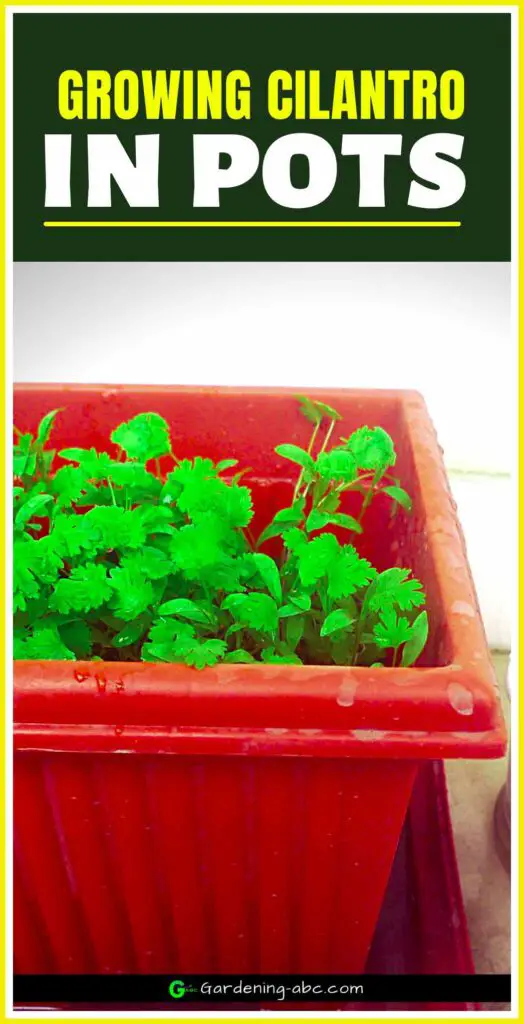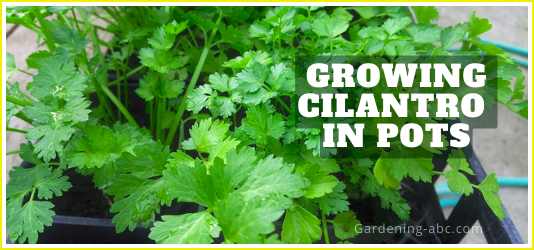We use affiliate links to run our site. When you buy through links on our site, we may earn an affiliate commission, without any added cost to you. Learn more
Cilantro is an herb that’s commonly used in Mexican, Asian and Indian cuisine. It has a distinct flavor that many people love.
Not long ago, I decided to plant some cilantro in pots on my balcony. It grows like a weed, so I figured it would be easy to grow. Apparently, that’s not the case for everyone.
Many people have asked me how to grow cilantro in a pot. Here’s in this post I will share what I did to successfully grow cilantro in pots.
The article will teach you everything about growing cilantro in containers so you can add more fresh herbs to your daily meals!
There are two ways you can start growing cilantro in pots
- Grow cilantro from seeds, and
- Use cuttings to grow the plant
Grow cilantro from seeds:
Propagating cilantro from seed is a simple process that you can do in your own home. You can purchase seeds online or at your local garden center.
If you purchase seeds online, they will arrive with instructions on how much water to use.
The best thing about growing cilantro in pots is you can move them out of the sun easily once temperatures begin to rise above 80 degrees.
Sow the seeds indoors. The ideal temperature should be around 50-80 degrees F. It would take 2 weeks for the seeds to germinate.
The seeds that we are referring to here, are not actually “seeds” in technical terms, rather these are the fruits of the plant. You can either sow it as a whole or you can split them and sow it separately.
Propagating Cilantro through cuttings:
If you have some cilantro plants growing outdoors, you can easily take cuttings from them using a sharp pruner and root them in water or soil to create new plants.
You’ll want to make sure your cutting has two sets of leaves on it before rooting it.
When To Plant Cilantro:
You can grow cilantro successively from spring to fall. If you live in tropical climates you can grow cilantro throughout the year, if you just take care of the bolting.
The best time to plant cilantro is in the early spring before hot summer temperatures set in.
How to Plant Cilantro:
Cilantro needs plenty of room so it can grow healthy and strong, so sow the seeds 1⁄2 inch deep with a space of 2 inches between two seeds and 4 inches between rows. This will give the seedlings room to grow without crowding each other out.
If you’re starting with young seedlings, plant them 3 inches apart within each row and 4 inches between rows for best results.
Ideal Pot Size:
Cilantro is one of the easiest herbs to grow, and it will do well in a variety of containers. The best pots for cilantro are those that have holes in the bottom so that excess water can drain out.
The pots should be at least 12 inches deep and 12 to 16 inches wide. It’s also important to choose containers with good drainage holes or saucers so that the water can drain out easily.
Mix garden soil and pebbles or rocks to create your own drainage layer at the bottom of your pot. Just make sure not to cover up all of your drainage holes!
Location:
Cilantro prefers full sun, but it will tolerate some shade. If you live in a warm climate, plant your cilantro outside after all danger of frost has passed and nighttime temperatures are consistently above 60 degrees F.
In cooler climates, start with seedlings indoors and move them outside once they’re large enough to withstand some cold.
Like most plants cilantro loves sunlight. So you should put them under direct sunlight. But you need to provide some cover from time to time otherwise the plant will bolt very quickly.
Potting Soil:
For growing cilantro in containers, use a good quality potting mix that doesn’t hold up water. Potting mixes work best as they are light, full of nutrients, and free from weeds and pathogens.
You can also use soil to grow cilantro in pots. Make sure the soil is fertile and loamy (not sandy), with good drainage so that excess water doesn’t remain on the surface for long periods of time.
You can add some compost or manure to increase the nutrient content of the soil. Ideally, the soil pH should remain between 6-7. Use a soil tester tool like this to find out the actual pH of the soil and make adjustments if it is not in that range.
If the pH is on the higher side, reduce the pH with these methods. If the soil is too acidic use these methods to bring down the acidity level of the soil.
Fertilizer:
A cilantro plant needs plenty of nutrients. A balanced fertilizer like this applied every three weeks should provide all of the nutrients needed by your cilantro plants.
Feed your plants monthly with a water-soluble fertilizer mixed at half strength. This will keep the leaves from turning brown and help them stay green longer into the season.
Another thing you can do is to add fish emulsion from time to time. this will keep your plants very happy.
Make sure you don’t over-fertilize the plants. It can cause more harm than good.
Can You Grow Cilantro indoors:
Yes. You can definitely grow cilantro indoors. If you have a sunny window, keep the growing pot near the window. Just avoid placing it not too close so it doesn’t get overheated.
Water the plant when the soil is dry, and feed regularly.
Pest and Diseases:
Cilantro is susceptible to the same pests and diseases as other members of the mint family. Aphids, whiteflies, spider mites, leaf miners, and thrips can all attack the plant.
The best way to fight these pests would be to keep the plant healthy and strong by keeping it well-watered and fertilized.
Keep distance between the plants, provide good air circulation and avoid overhead watering.
You can also use companion plants or these 12 organic pest control methods to prevent pests from attacking the plant.
When to Harvest:
The best time to harvest cilantro is when its leaves are about 6 inches tall.
You can also harvest cilantro when its leaves are 3-4 inches tall but it will have a more intense flavor if you wait until the plant has reached about 6 inches.
Cut the entire plant at the soil level just above the roots with a sharp knife or pruning shears.
Wash off any dirt from under the leaves, then store in a plastic bag in your refrigerator for up to three days or freeze in an airtight container.
- If you are growing cilantro in a container, always use a bigger container like this so you can grow many plants in a single container.
- Though almost all the varieties will produce leaves and seeds, it is better to look for slow bolting varieties so you can enjoy the leaves for a longer period of time.
- In normal conditions, the germination rate of coriander is close to 50%. To increase the germination rate, soak in water for 3 days and then sow it into the soil.
- Put the seed into a healthy potting mix or well-drained soil. To make the soil ready you can add manure or compost to the soil.
Conclusion:
Growing cilantro in pots is a great way to have fresh cilantro available year-round and it is very easy to grow also.
It also allows you to move the plants as needed, making them ideal for growing indoors or on balconies where space may be limited. You can save time, money, and a lot of effort.
I hope this post was helpful to you and you have learned something new. You will find a lot of helpful posts about growing cilantro here, so do check that out.
If you like the information, share it with others, and Don’t Forget to PIN IT.

Amazon and the Amazon logo are trademarks of Amazon.com, Inc, or its affiliates.

Hi there! My name is Prasenjit and I’m an avid gardener and someone who has grown a passion for growing plants. From my hands-on experience, I have learned what works and what doesn’t. Here I share everything I have learned.
